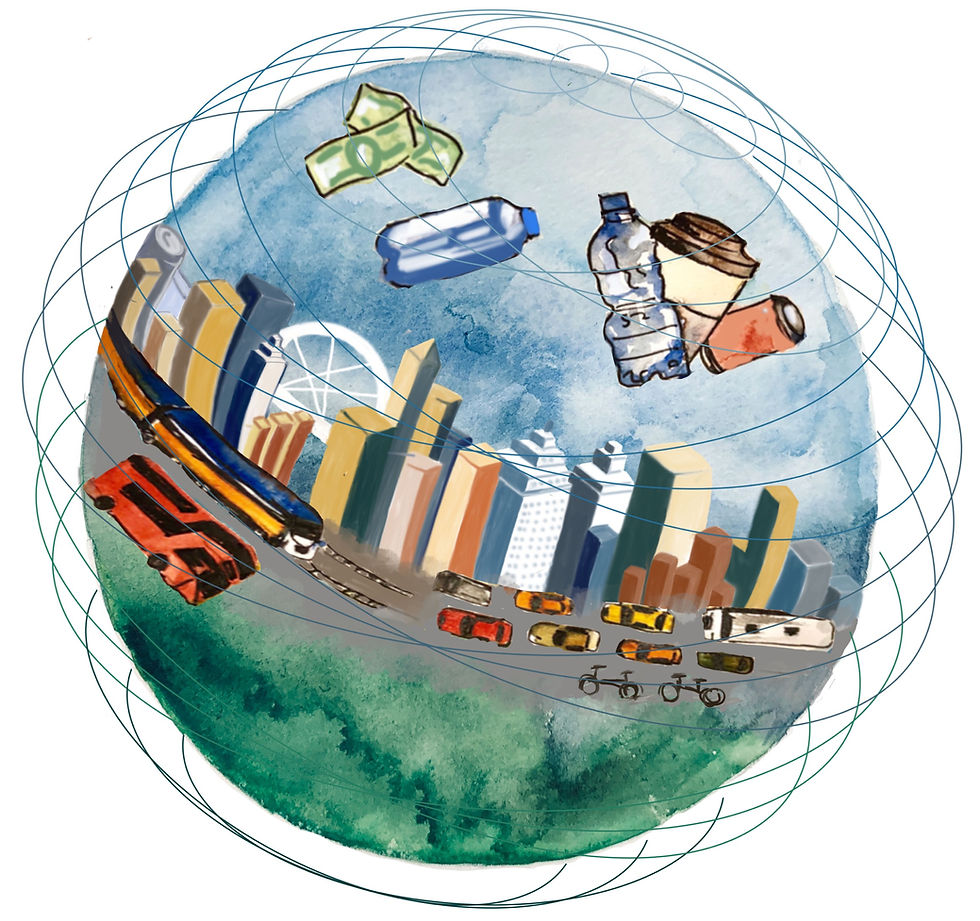Closing the Production Loop
- Anthroposphere

- May 28, 2019
- 7 min read
How circular economies can bridge the emissions gap
By Hannah Simon

In October 2018, the Intergovernmental Panel on Climate Change (IPCC) released its Special Report on Global Warming of 1.5°C. The report highlighted the disturbing scenarios that could ensue if global warming reaches or exceeds 2°C in the years to come. Global sea level rise would inundate entire communities, food resources would be too scarce to sustain lives and livelihoods, and the world’s coral reefs would disappear altogether. The following month, UN Environment released its Emissions Gap Report, which stated that while it is still possible to maintain global warming below 2°C, the climate pledges that have been made to date are insufficient for such a task. Following the release of both reports, ecologists, climate scientists, policy-makers, and laypeople alike were catapulted into paroxysms of solutions for how to reduce the world’s carbon emissions. One solution sought was that of the circular economy (‘CE’) approach, and its potential to address the contributions of cities to climate change.
*
Since the days of industrialisation, humans have adopted a linear approach to material use. This commonly proceeds as such: companies extract natural resources, use them to manufacture products, and sell these products to consumers who discard them when they outlive their usefulness. Unlike this linear human approach, materials in the natural world flow within circular, regenerative systems. The growth of plants is powered by the sun; one species becomes another’s food; things die, they decompose, and their nutrients feed soils that bring life to something else. In effecting a paradigm shift away from the unsustainable practices of taking, making, and wasting resources and instead towards closing the production loop, the CE concept simulates nature’s cyclical model of material use.
There are well over 100 definitions and conceptualisations of the CE, many of which are incomplete, contradictory or absurd. The unofficial authority on circular thinking, the Ellen MacArthur Foundation, has formulated three principles that best articulate the concept: i) design out waste; ii) strictly differentiate between consumable (biological) and durable (technical) components of a product; and iii) ensure the energy required to fuel the economy is renewable and recoverable. These principles are illustrated in the figure below.

The principles described above underpin many CE case studies around the world, almost all of which occur in cities. But why cities? Firstly, and perhaps most importantly, cities are responsible for 75% of the world’s natural resource consumption and nearly 80% of its greenhouse gas (GHG) emissions. Cities also contain a cornucopia of material resources, big data, and human capacity. Furthermore, legislative complexities and government red tape are easier to navigate within cities (as opposed to whole countries), which makes changing laws and policies – around, for example, consumption and production – possible over the short term.
While we can accredit cities as suitable territories for circular processes, can we imagine how a fully circular city looks, feels and operates? How can we begin to understand how circular cities can bridge the emissions gap?
A circular city is one in which the built environment is flexible and modular, made from non-toxic materials that can be disassembled and reused. The Tower Hotel in Yueyang, for example, was assembled off site, a process that reduced material waste, water usage, and the amount of carbon emissions released. In addition to being modularly built, the building is sustainable by design where, for example, it has thermal insulation and paned windows to keep the interior cool without relying on air-conditioning. Occasionally, buildings in the circular city make food, too. Lufa, a Montreal-based food company, has pioneered hydroponic urban farming on the city’s previously underutilised rooftops and, like all food systems in the circular city, takes advantage of biological cycles, repurposes waste and recycles nutrients back into the soils that made it.
Energy systems in the circular city are renewable, resilient, inclusive and efficient. An initiative in New York, for example, is leveraging blockchain technology so that individuals can exchange solar-generated energy with their neighbours, thereby reducing the reliance on an emissions-heavy centralised grid. These energy systems power transport systems that are made for sharing, reduce congestion and pollution, and get us to where we need to go in an affordable, accessible and low-carbon way. Take Mobike, a fully station-less bicycle sharing system pioneered in Shanghai. Within the initiative’s first year of operation, it had reduced carbon emissions by more than 1.2 million tonnes, comparable to taking 350,000 cars off the road for a year. Just like transport systems, products and materials in the circular city are shared, leased or rented, and those that are not biodegradable are designed to be disassembled, repaired and reused. In this sharing economy, durable materials (such as valuable metals, polymers and alloys) are extracted from old cellphones, computers, dishwashers, and sold back to the producer for the production of the next generation of gadgets.
*
Under business-as-usual scenarios, the world’s GHG emissions will induce increases in global temperatures of at least 4°C by 2100, bringing with it considerable devastation to natural and human systems. If we want to limit this increase to 1.5°C – as stipulated in The Paris Agreement – our projected annual emissions must decrease by 26 billion tonnes per annum. However, commitments under the Agreement can only deliver a reduction of, at most, half of this amount. This is where cities come in: independent studies estimate that circular cities can address the remaining half. The Ellen MacArthur Foundation, for example, estimates that if the mobility, food, and built environment sectors in Europe become circular, carbon emissions from these sectors will be reduced by 48% by 2030, which alone is sufficient to close the emissions gap.
Critics of the CE concept argue that circularity has little utility in closing the emissions gap because its development is just an elaborate rebranding exercise. However, the ability to help the world meet its climate goals is what separates CEs from other conventionally ‘green’ or ‘smart’ activities. Take recycling, for example, which holds consumers responsible for converting waste into something useful. The CE takes this responsibility one step further by expecting manufacturers to produce goods that generate less waste in the first place, and that encourage consumers to integrate recycling into their lives more diligently. Moreover, CEs frame these activities within city-wide systems and processes, which amplifies the scale at which they can operate and, ultimately, the change that they can effect. This systems approach is buttressed by partnerships between: sectors, such as the public and private sectors; industries, such as fashion, technology and environment; and multinational organisations, such as Google and Arup. By capitalising on the minds and resources of such partnerships, the CE becomes a delivery mechanism for countries to fulfil their ambitious climate commitments.
*
Despite its promising potential, the CE concept has its challenges, many of which arise from its utopian ideals that are desirable but perhaps too complex and difficult to implement. And then there are challenges related to equity, employment, and entropy.
Many CE initiatives are inequitable. While the ‘sharing’ economy (of tools, transport and office spaces) that underpins circularity saves money (an estimated US$4.5 trillion globally by 2030!), it is also dominated by large and powerful corporations. Cost savings within such corporations exacerbate their influence, subsequently worsening existing inequalities within the sectors and countries that they operate. Circular policies in developed countries can also hinder trade opportunities for developing ones. Already, the EU Circular Economy Action Plan is undermining import demand for raw and processed materials from developing countries. So, while economic gains for big and powerful corps and countries are already apparent under the CE framework, those for smaller businesses and developing countries seem, at least in comparison, few and far between.
The CE is also being marketed as a panacea for unemployment. By 2030, the CE could generate over a million jobs across Europe. In India, car-sharing firms have already created 30,000 new jobs in the state of Tamil Nadu alone. Moreover, such jobs span various skills levels – from ‘low’ in recycling, to ‘medium’ in remanufacturing, to ‘high’ in bio-refining. However, looking beyond just enumeration reveals that CE jobs often offer fewer benefits, less security and fewer opportunities for professional growth. The question then remains whether these new jobs with fewer benefits are better than no jobs at all.
Entropy is another significant issue. The CE can recycle materials back into the system for reuse efficiently. However, products and materials cannot be endlessly recycled and regenerated. Indeed, materials get dispersed and degraded through their transformation and it becomes impossible to collect every fragment of what once was. Hence, the overall environmental benefit of CEs is likely to be largely offset not just by the fact that nothing is 100% recyclable, but also by encouraging the consumption of cheap products. Overcoming this challenge requires not just a change in how and what we produce, but also how much and how fast we consume.
A circular economy in which everyone wins therefore requires large shifts in the way that societies perceive growth and development. Achieving such shifts will be difficult, mostly because they are just as ambitious as the targets and agreements that precipitated them. Still, such ambition is precisely what is needed to thwart the impending impacts of climate change.
Hannah Simon is a climate change analyst at C4 EcoSolutions, a Cape Town-based environmental consultancy. She helps global players unlock funds for building climate resilience in vulnerable communities around the world. Hannah has helped develop dozens of adaptation and mitigation projects in nations across Africa, South America and Asia. This work piqued her interest in urban ecology, ecosystem-based adaptation and circular economies. Prior to working at C4, Hannah completed her undergraduate and honours degrees at the University of Cape Town in South Africa. She is due to start reading for a MSc in Environmental Change and Management this year at St Peter's College, Oxford. When not working, Hannah likely to be sound swimming, traversing Table Mountain, photographing the people she loves, or watching Bill Murray movies.
Art by Julia Jones
This article first appeared in the print edition of Anthroposphere Issue III. If you like what you've just read, please support Anthroposphere by buying one of our beautifully designed physical copies here. All proceeds go towards printing, designing and maintaining our publication, and your contributions will help keep our climate journalism interdisciplinary and accessible for all.




Comments